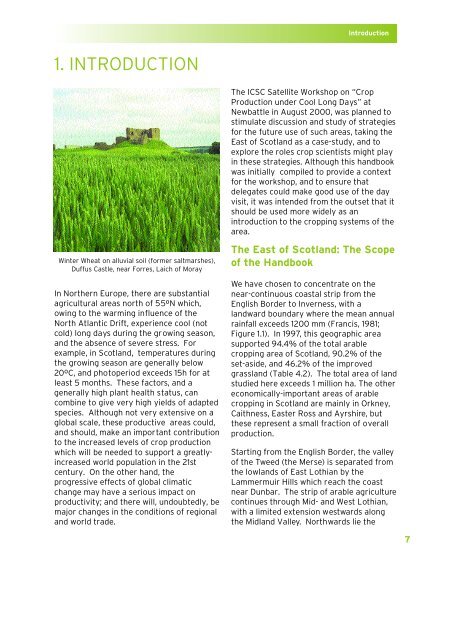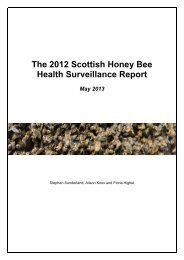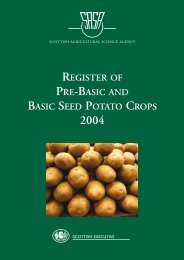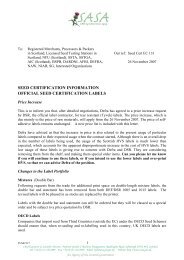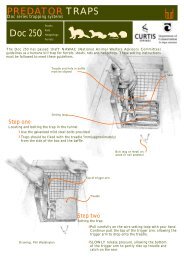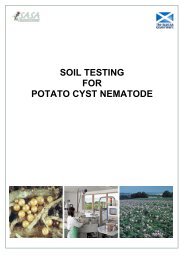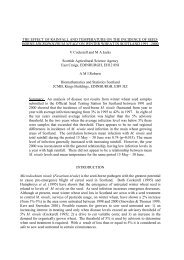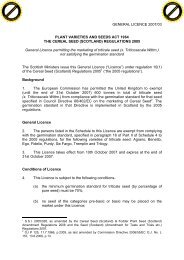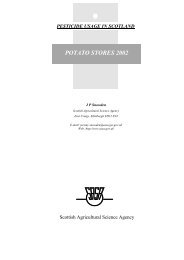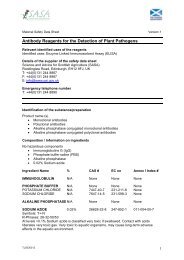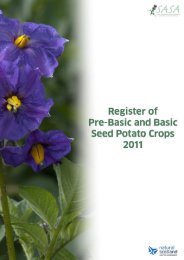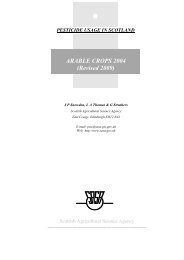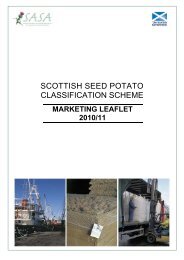You also want an ePaper? Increase the reach of your titles
YUMPU automatically turns print PDFs into web optimized ePapers that Google loves.
Introduction1. INTRODUCTIONThe ICSC Satellite Workshop on “<strong>Crop</strong><strong>Production</strong> under Cool Long Days” atNewbattle <strong>in</strong> August 2000, was planned tostimulate discussion and study <strong>of</strong> strategiesfor <strong>the</strong> future use <strong>of</strong> such areas, tak<strong>in</strong>g <strong>the</strong><strong>East</strong> <strong>of</strong> <strong>Scotland</strong> as a case-study, and toexplore <strong>the</strong> roles crop scientists might play<strong>in</strong> <strong>the</strong>se strategies. Although this handbookwas <strong>in</strong>itially compiled to provide a contextfor <strong>the</strong> workshop, and to ensure thatdelegates could make good use <strong>of</strong> <strong>the</strong> dayvisit, it was <strong>in</strong>tended from <strong>the</strong> outset that itshould be used more widely as an<strong>in</strong>troduction to <strong>the</strong> cropp<strong>in</strong>g systems <strong>of</strong> <strong>the</strong>area.W<strong>in</strong>ter Wheat on alluvial soil (former saltmarshes),Duffus Castle, near Forres, Laich <strong>of</strong> MorayIn Nor<strong>the</strong>rn Europe, <strong>the</strong>re are substantialagricultural areas north <strong>of</strong> 55ºN which,ow<strong>in</strong>g to <strong>the</strong> warm<strong>in</strong>g <strong>in</strong>fluence <strong>of</strong> <strong>the</strong>North Atlantic Drift, experience cool (notcold) long days dur<strong>in</strong>g <strong>the</strong> grow<strong>in</strong>g season,and <strong>the</strong> absence <strong>of</strong> severe stress. Forexample, <strong>in</strong> <strong>Scotland</strong>, temperatures dur<strong>in</strong>g<strong>the</strong> grow<strong>in</strong>g season are generally below20ºC, and photoperiod exceeds 15h for atleast 5 months. These factors, and agenerally high plant health status, cancomb<strong>in</strong>e to give very high yields <strong>of</strong> adaptedspecies. Although not very extensive on aglobal scale, <strong>the</strong>se productive areas could,and should, make an important contributionto <strong>the</strong> <strong>in</strong>creased levels <strong>of</strong> crop productionwhich will be needed to support a greatly<strong>in</strong>creasedworld population <strong>in</strong> <strong>the</strong> 21stcentury. On <strong>the</strong> o<strong>the</strong>r hand, <strong>the</strong>progressive effects <strong>of</strong> global climaticchange may have a serious impact onproductivity; and <strong>the</strong>re will, undoubtedly, bemajor changes <strong>in</strong> <strong>the</strong> conditions <strong>of</strong> regionaland world trade.The <strong>East</strong> <strong>of</strong> <strong>Scotland</strong>: The Scope<strong>of</strong> <strong>the</strong> HandbookWe have chosen to concentrate on <strong>the</strong>near-cont<strong>in</strong>uous coastal strip from <strong>the</strong>English Border to Inverness, with alandward boundary where <strong>the</strong> mean annualra<strong>in</strong>fall exceeds 1200 mm (Francis, 1981;Figure 1.1). In 1997, this geographic areasupported 94.4% <strong>of</strong> <strong>the</strong> total arablecropp<strong>in</strong>g area <strong>of</strong> <strong>Scotland</strong>, 90.2% <strong>of</strong> <strong>the</strong>set-aside, and 46.2% <strong>of</strong> <strong>the</strong> improvedgrassland (Table 4.2). The total area <strong>of</strong> landstudied here exceeds 1 million ha. The o<strong>the</strong>reconomically-important areas <strong>of</strong> arablecropp<strong>in</strong>g <strong>in</strong> <strong>Scotland</strong> are ma<strong>in</strong>ly <strong>in</strong> Orkney,Caithness, <strong>East</strong>er Ross and Ayrshire, but<strong>the</strong>se represent a small fraction <strong>of</strong> overallproduction.Start<strong>in</strong>g from <strong>the</strong> English Border, <strong>the</strong> valley<strong>of</strong> <strong>the</strong> Tweed (<strong>the</strong> Merse) is separated from<strong>the</strong> lowlands <strong>of</strong> <strong>East</strong> Lothian by <strong>the</strong>Lammermuir Hills which reach <strong>the</strong> coastnear Dunbar. The strip <strong>of</strong> arable agriculturecont<strong>in</strong>ues through Mid- and West Lothian,with a limited extension westwards along<strong>the</strong> Midland Valley. Northwards lie <strong>the</strong>7


